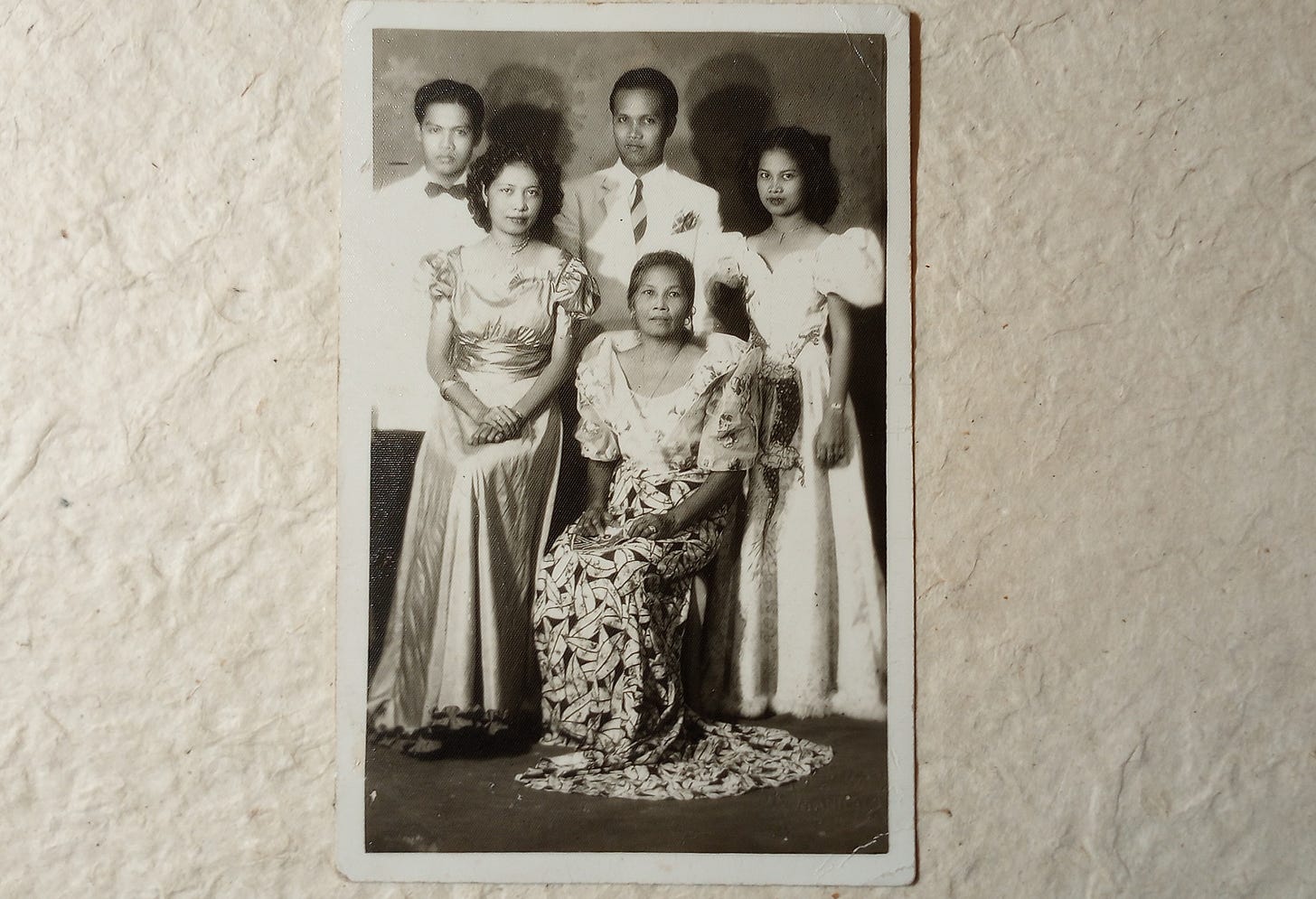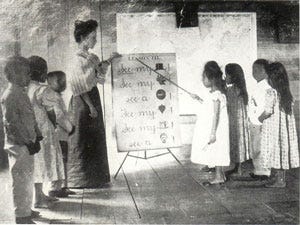Tagalog vs. English
#179: Then & Now (Learning Tagalog), Kids React to Art, Sijia Chen, The Traumatic Surreal, Mierle Laderman Ukeles, George Grosz, James Winestock, Santana and Richie Havens at Woodstock, and MyNoise
THEN & NOW
Learning Tagalog (again):
I haven’t read my lola (grandmother) Matea’s letters, since my knowledge of Tagalog—first learned during graduate school—has degraded significantly over the years.1 If you don’t use it, you lose it. Nevertheless, I want to read them, so today I put a library hold on a Tagalog language instruction book that comes with audio lessons.

What do I hope to learn from reading my lola’s letters? Will I somehow become “closer” to the grandmother I never met? Will I learn something new about my mom? During the first decade of my life, Mom and I together dealt with various challenges—some of which involved my own health issues. That two-person unit (with twice-a-year visits from Dad) seemed like family enough for me. I watched my mom develop a sense of independence and perseverance that came from having to figure out everything on her own. I’m sure, however, that the frequent air-mail letters we received provided some appreciated support and reassurance for her.
Thomasite Education & English:
Since my lolo (grandfather) was a member of the Philippine Constabulary,2 Mom and her siblings attended a military-dependent school (grades 1-7) at Fort Stotsenburg, now known as Clark Air Base.3 The school was founded in 1918 by Governor-General Leonard Wood; Mom told me that my aunt Leonarda (Dading) was named after him.
Soon after the US won the Philippine-American war, they began a campaign to open a new public school system (replacing the Spanish colonial schools) in the Philippines and thus promote American values. The first teachers were members of the US military. However, they were later replaced by 600 civilian American school teachers who sailed to the Philippines aboard the USAT Thomas. The University of Michigan gives a brief history of the Thomasites, as they became known. The young Filipino students were required to speak English at school, and were fined or punished if they spoke their native language.

My mother came out of that education as a “believer” in “the American way of life,” in the rightness of its ideals, in its language, its modernity, and its overall superiority. Her World War II experience—especially the American liberation4 of Manila from Japanese forces—only confirmed that. My parents decided together that they would not teach me a Philippine language, and they would speak to me only in English.
Eventually, I earned a PhD in English, along with conflicted feelings about my chosen major, teaching, and academia in general. But that’s another story . . .
RABBIT HOLE
Kids react to modern art (Southbank Centre):
Sijia Chen’s art tells immigrant stories:
The development of surrealism in relation to trauma: “The Traumatic Surreal” (from the Henry Moore Institute:
Mierle Laderman Ukeles’ art addresses issues of domestic maintenance, while critiquing power structures in the art world and in museums:
George Grosz’s art satirically portrayed WWI and the moral decay of the Weimar Republic leading to the Nazi regime in WWII:
A much-needed reminder. From James’s Substack (James Winestock): “Stop Pretending You’re Not Tired.”
SOUNDINGS
Two from Woodstock:
The Latin rock group Santana (named after lead guitarist Carlos Santana) performed “Soul Sacrifice” at Woodstock in 1969. Someone reacting to this recently said that the band “opened a portal” during this performance, and I agree—they were in the zone, along with the audience:
Richie Havens singing “Freedom” at Woodstock—another powerful performance:
MyNoise: Need some background sounds or music to help you focus? Mynoise.net provides just about any sound you need, provided free by Dr. Stéphane Pigeon. You can also get creative and mix your own ambience. Some sounds are designed specifically for certain needs. Because we’ve had a lot of construction near the house lately, I can pick sounds from MyNoise that effectively mask the racket outside; Tibetan chants are great for that—there are several versions. The sounds provided on the first page are just an intro. I strongly suggest that you scroll to the bottom of the page and check out the full index. And if you are able, make a donation; Dr. Pigeon provides a great service.
My gratitude goes to everyone who reads Eulipion Outpost regularly, and especially to those who have subscribed or donated on my Ko-fi page to support my efforts.
My ongoing appreciation goes to the Mysterious M. for his excellent editing skills.
Website and blog: Jeanvengua1.wordpress.com
A Crooked Mile (blog).
Eulipion Outpost is a reader-supported publication. To receive new posts and support my work, consider becoming a free or paid subscriber.
My parents made the decision speak to me only in English. When I told my mom I wanted to learn Tagalog in college, she suggested I learn Spanish, instead. That colonial mindset is not unusual among older Filipinos, especially those from the WWII era.
Administered by the U.S. Army.
Located near Angeles City, about 80 km north of Manila.
It was a liberation that unfortunately involved almost complete destruction of Manila through aerial bombardment, shelling, and fire-setting (the latter two by both Japanese and American forces), with over 100,000 Filipino deaths in Manila alone.





There's a saying I read in a book: "Spain built churches, America built schools, and Japan built brothels." The last line is particularly horrific if you know the histories.
Good account.I suspect you have been reading about the kidnapping of Americn Indian children into English only boarding schools and the attept to strip away all aspects of tribal cultural practices. A Christian goverment hard at work!!